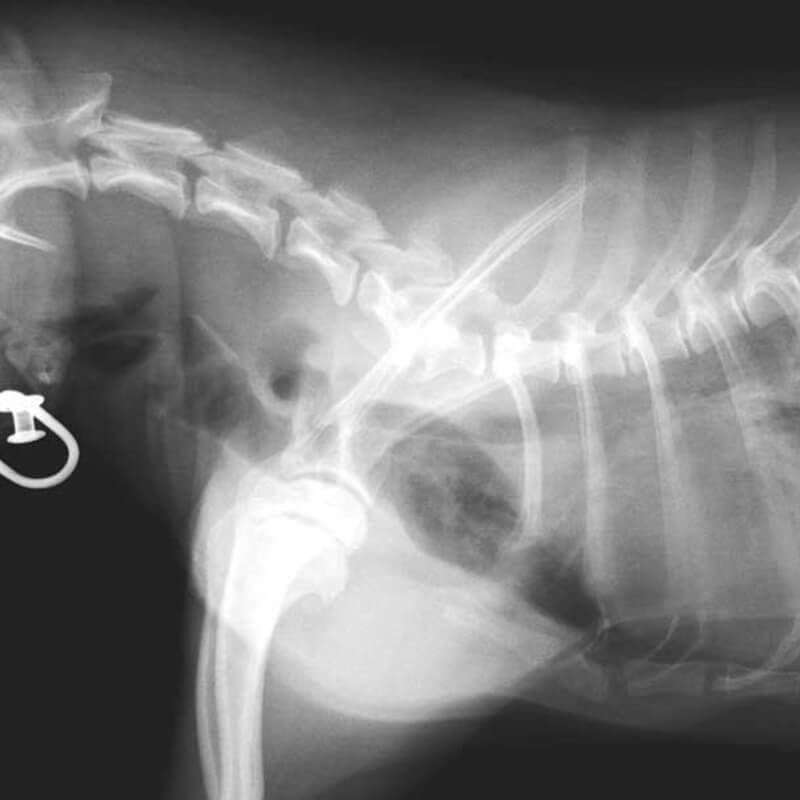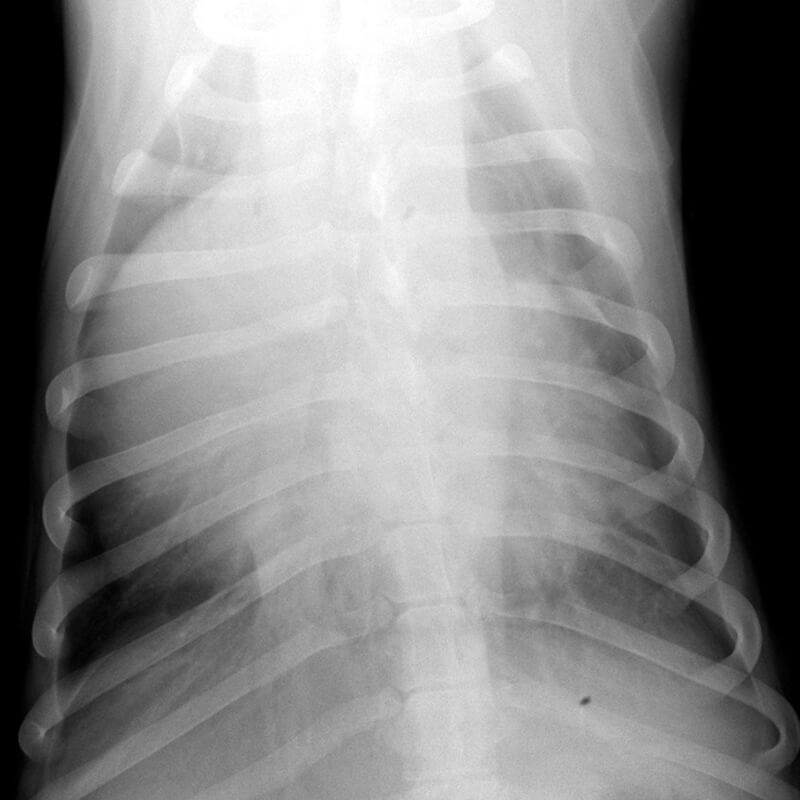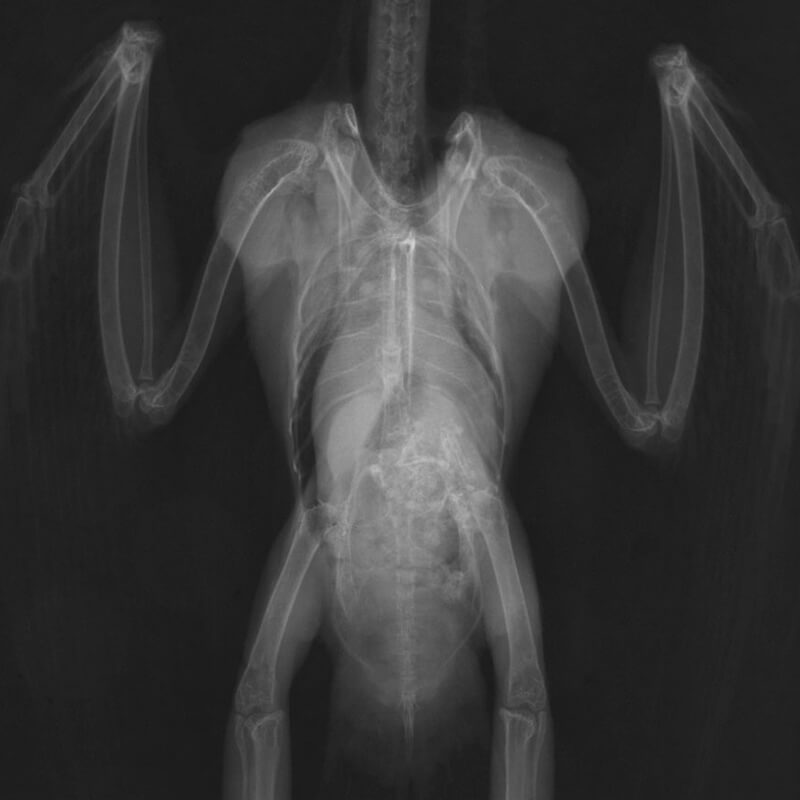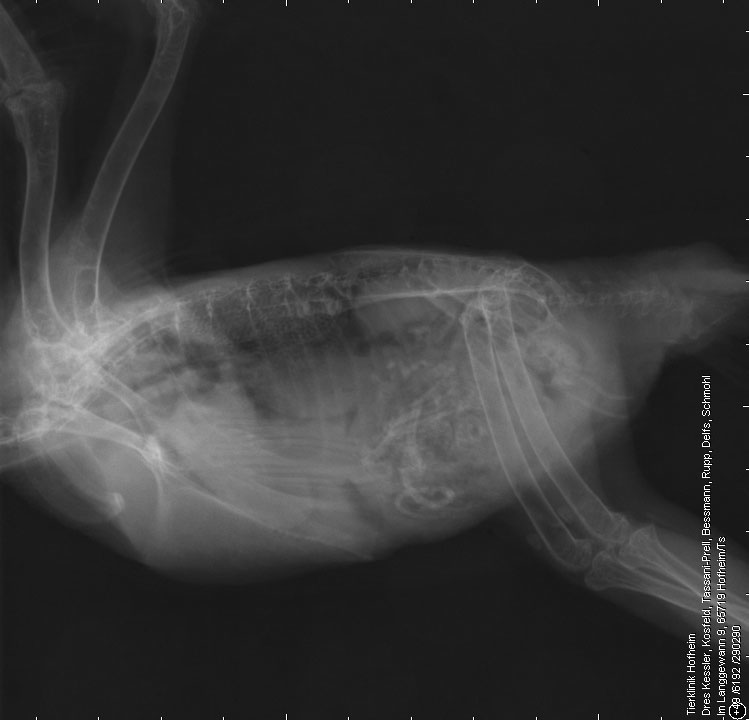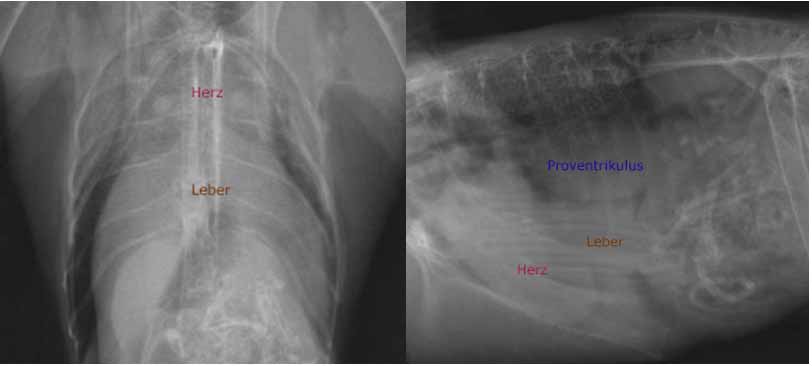Maltese dog Jimmy, 9 years
Diagnosis
Description
Barrel-chested thoracic confirmation. Normal body condition. Expiratory view with reduced thoracic volume on the lateral radiograph, good inspiratory ventrodorsal (VD) view. The 2nd sternebra is shorter with a flat caudal endplate. Mild step formation between 2nd and 3rd sternebae.
Spondylosis arising from the endplates of C6/7. Small amount of new bone formation at caudal aspect humeral heads.
The diaphragm is intact. The crurae are crossing T9 (expiratory view).
The liver is of homogenous soft tissue opacity. The stomach contains food material. On the lateral radiograph the neck is in a slightly flexed position. Larynogpharynx and larynx contain air. The cervical portion of the trachea is slightly narrower than the larynx, however overall it is wide. At the level of C6 the trachea shows an abrupt narrowing and runs dorsally resulting in an S-shaped kink.
Caudal to the kink the trachea has a reduced diameter, of approximately half the height of the larynx.
The intrathoracic portion of the trachea is barely visible and of soft tissue opacity.
At the level of the bifurcation the trachea as well as the main stem bronchi are not visible due to collapse.
At the level of C6, dorsal to the S-shaped tracheal kink, a crescent-shaped, clearly delineated gas accumulation is visible.
On the lateral radiograph the cardiac silhouette appears subjectively large, occupying 4 intercostal spaces and approximately 90% of the thoracic height. On the VD radiograph the cardiac silhouette is unremarkable. It occupies approximately 60% of the thoracic width.
No pathologic bulges are present on either view. The lung vessels are within normal limits. On the lateral radiograph the lung shows an overall increased opacity with a reticular pattern. Cranial to the cardiac silhouette a wing-like gas structure is visible extending from the cardiac silhouette into the caudal cervical area to C6. Centrally it contains slightly unsharp, fish bone like, soft tissue dens bands. On the VD radiograph the lung is within normal limits. The wing-like structure is not visible.
Radiographic diagnoses
- Collapse intrathoracic portion of the trachea
- Collapse of the main stem bronchi
- Kinking caudal cervical trachea
- Wing-like gas opaque structure cranial to the cardiac silhouette extending into the neck
- Crescent shaped gas opaque structure dorsal to trachea
- Interstitial lung pattern lateral radiograph
- Spondylosis C6/7
- Malformation 2nd sternebrae with step formation
- Bilateral mild osteoarthritis shoulder joint
Discussion
The wing-like gas opaque structure cranial to the cardiac silhouette represent unilateral or bilaterally herniated cranial lung lobe(s). Lung lobe herniation is defined as the protrusion of lung parenchyma beyond the level of the thoracic boundaries. It is described to occur as a sequel to chronic respiratory distress and is strongly associated with collapse of the intra-thoracic trachea and major bronchi. Kinking of the extra-thoracic part of the trachea occurs in up to 1/3 of dogs.
The crescent shaped gas opaque structure dorsal to the trachea is most likely the gas filled oesophagus. Aerophagia could very well be explained by respiratory distress due to the tracheal and bronchial collapse. Most likely gas had been swallowed during acquisition of the radiograph.
The interstitial lung pattern is due to lack of lung aeration due to the expiratory nature of the lateral radiograph. The subjectively large cardiac silhouette on the lateral radiograph is due to the barrel-chested body confirmation and therefore the reduced thoracic height as well as the reduced thoracic volume due to expiration.
The malformation of the 2nd sternebrae is most likely due to an old trauma, differential diagnosis is a congenital malformation.
References
- Dynamic Cervical Lung Hernia in a Dog with Chronic Airway Disease. Coleman et al. J. Vet. Int. Med. 2005
- Cervical lung lobe herniation in dogs identified by fluoroscopy. Nafe et al. Can. Vet. J. 2013
- Intermittend cranial lung herniation in two dogs. Guglielmini et al. Vet. Radiol. Ultraound 2007
